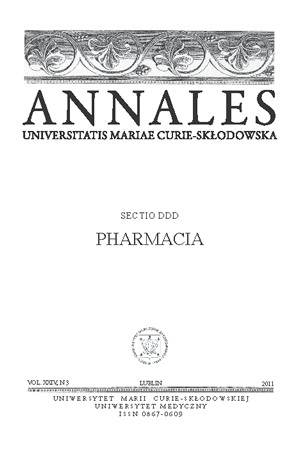Nfe2 expression in the hyperthyroid rat heart receiving doxorubicin
DOI:
https://doi.org/10.12923/Keywords:
Doxorubicin, thyroxin, hyperthyreosis, Nfe2 (Nrf2) expression, NADPH, glutathione, oxidative stressAbstract
The most evidence suggests that the major cause of doxorubicin (DOX) cardiotoxicity is reactive oxygen species and consequently oxidative stress. The accumulation of oxidative damages leading to mitochondrial dysfunction results in contractility disorders. In a cell adaptive process against oxidative stress, the transcription factor Nrf2 (Nfe2) plays a crucial role by stimulating expression of genes controlling synthesis of enzymes taking part in oxidative defence and red-ox equilibrium, e.g. glucose-6-phosphate dehydrogenase, phosphogluconate dehydrogenase and malic enzyme. Expression of genes responsible for the synthesis of these enzymes is controlled by iodothyronine hormones. These facts lead to an assumption that the impact of anthracyclines on oxidative stress may differ in hyperthyroid and euthyroid individuals. In these studies first of all we tested the hypothesis that symptoms of oxidative stress may be evident long time since last dose of DOX and if hypothyreosis may change myocardium antioxidative response in rats which received DOX. There was no statistical difference in Nfe2 expression in hearts of rats after doxorubicin administrations (group of DOX) versus controls. In this group there were no statistical differences in cardiac NADPH and total mitochondrial glutathione concentrations and GSH/GSSG ratio comparing to the controls. Moreover, any changes in all tested parameters were observed between DOX vs. DOX+4T4. We concluded that after three weeks since last doxorubicin administration there were no significant signs of oxidative stress in the heart, and that in our study conditions there was no interaction of DOX and thyroxin referring to oxidative stress in the myocardium.
References
1. Berthiaume J.M., Wallace K.B. Adriamycin-induced oxidative mitochondrial cardiotoxicity. Cell. Biol. Toxicol., 2007, 23, 15-25.
2. Cadenas E., Davies K.J. Mitochondrial free radical generation, oxidative stress, and aging. Free Radic. Biol. Med., 2000, 29: 222-30.
3. Flores-Morales A., Gullberg H., Fernandez L., et al. Patterns of liver gene expression governed by TRbeta. Mol. Endocrinol., 2002, 16, 1257-1268.
4. Hayashi A., Suzuki H., Itoh K., et al. Transcription factor Nrf2 is required for the constitutive and inducible expression of multidrug resistance-associated protein 1 in mouse embryo fibroblasts. Biochem. Biophys. Res. Commun., 2003, 310, 824-9.
5. Hayes J.D., Flanagan J.U., Jowsey I.R. Glutathione transferases. Annu. Rev. Pharmacol. Toxicol., 2005, 45, 51-88.
6. Kensler T.W., Wakabayashi N., Biswal S. Cell survival responses to environmental stresses via the Keap1-Nrf2-ARE pathway. Annu. Rev. Pharmacol. Toxicol., 2007, 47, 89-116.
7. Lebrecht D., Kokkori A., Ketelsen U.P., et al. Tissue-specific mtDNA lesions and radical-associated mitochondrial dysfunction in human hearts exposed to doxorubicin. J. Pathol., 2005, 207, 436-44.
8. Lebrecht D., Setzer B., Ketelsen U.P., et al. Time-dependent and tissue-specific accumulation of mtDNA and respiratory chain defects in chronic doxorubicin cardiomyopathy. Circulation. 2003, 108, 2423-9.
9. Lebrecht D., Walker U.A. Role of mtDNA lesions in anthracycline cardiotoxicity. Cardiovasc. Toxicol., 2007, 7, 108-13.
10. Lombardi A., Beneduce L., Moreno M., et al. 3,5-diiodo-L-thyronine regulates glucose-6-phosphate dehydrogenase activity in the rat. Endocrinology. 2000, 141, 1729-1734.
11. Minotti G., Menna P., Salvatorelli E., et al. Anthracyclines: molecular advances and pharmacologic developments in antitumor activity and cardiotoxicity. Pharmacol. Rev., 2004, 56, 185–229.
12. Moinova H.R., Mulcahy R.T. Up-regulation of the human gamma-glutamylcysteine synthetase regulatory subunit gene involves binding of Nrf-2 to an electrophile responsive element. Biochem. Biophys. Res. Commun., 1999, 261, 661-8.
13. Orrenius S., Gogvadze V., Zhivotovsky B. Mitochondrial oxidative stress: implications for cell death. Annu. Rev. Pharmacol. Toxicol., 2007, 47, 143-83.
14. Thimmulappa R.K., Mai K.H., Srisuma S., et al. Identification of Nrf2-regulated genes induced by the chemopreventive agent sulforaphane by oligonucleotide microarray. Cancer Res., 2002, 62, 5196-203.
Downloads
Published
Issue
Section
License
Copyright (c) 2011 Authors

This work is licensed under a Creative Commons Attribution-NonCommercial-NoDerivatives 3.0 Unported License.


